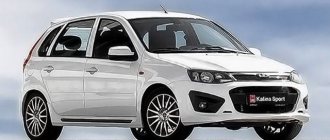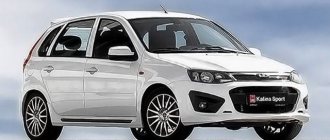Engine VAZ 11194
The 1.4-liter 16-valve VAZ 11194 engine was produced by the concern from 2007 to 2013 and was essentially a smaller copy of the popular VAZ 21126 power unit. The engine was specially created and was installed only on the Lada Kalina hatchback, sedan and station wagon.
The VAZ 16V line also includes: 21124, 21126, 21127, 21129, 21128 and 21179.
Bubbling and diesel engine Lada Kalina 1.6 8cl
After purchasing my Kalina two years ago, it was very unusual for me to listen to a strange sound when the engine was running, especially during sub-zero temperatures. I remember all my previous cars, there was no such problem, and so at first I thought that there was something wrong with the car. But when I listened to the sound of the other owners, I realized that all 8-valve engines on the Lada Kalina work this way.
By the way, in the summer this bubbling is not so pronounced and is noticeable only in the first minutes after starting the engine, and even then it is not a very pronounced sound. But in winter you have to listen to diesel quite often, especially in the morning in good frosts, until the engine warms up to at least 50 degrees. Then, gradually these sounds become quieter and when they reach 90 degrees, for me personally, they go away completely!
At one time, this problem was discussed on the Kalina Club forum, but there, in fact, many owners were in a panic, drove their cars to official dealers for service, asked to fix this problem under warranty, etc. But in almost all cases they were told that this is the design of this 1.6 8-valve engine and nothing can be done about it. All you have to do is get used to it, because this obviously doesn’t affect the traction and the other parameters of the power unit either! So why bother yourself with incomprehensible questions and doubts? As they say, don't stop the machine from working!
Although there are also owners who nevertheless decided to get rid of this bubbling and dismantled their engines, some at home in garages, and some in a car service center, I never heard from them later whether they managed to get rid of diesel, or everything remained in place and this strange sound did not disappear anywhere. Maybe there are drivers here who have solved this problem, many are wondering what exactly is the design flaw of this 8-valve engine? I heard an opinion that this strange sound occurs on a cold engine due to the fact that the piston stroke in the 1.6 modification has increased, and accordingly, while the oil is cold, it does not have time to properly lubricate the piston and this grunting occurs! I wonder if these are just assumptions or are there lucky people who managed to get rid of this illness from Kalina? Share your experience!
Technical characteristics of the VAZ 11194 1.4 16kl engine
| Type | in-line |
| Number of cylinders | 4 |
| Number of valves | 16 |
| Exact volume | 1390 cm³ |
| Cylinder diameter | 76.5 mm |
| Piston stroke | 75.6 mm |
| Supply system | injector |
| Power | 89 hp |
| Torque | 127 Nm |
| Compression ratio | 10.6 — 10.9 |
| Fuel type | AI-92 |
| Environmental standards | EURO 3/4 |
Design features of the Lada 11194 16 valve engine
The 1.4-liter internal combustion engine is based on the 1.6-liter VAZ 21126 by reducing the piston diameter. The combustion chamber, which was reduced as a result, deprived the unit of normal traction at the bottom, and therefore it is not very comfortable to constantly move in dense city traffic.
As in the donor, a lightweight connecting rod and piston group from Federal Mogul is used here, which, with all its advantages, has one disadvantage: if the timing belt breaks, the valve bends 100%. And the presence of hydraulic compensators allows you not to have to adjust valve clearances. In all other respects, this is a typical VAZ sixteen-valve engine, only of a smaller volume.
At one time I wrote about this engine at the wheel, although comparing it with the ICE 21124
Source
Cross section of engine 11194*: 1 — oil pan drain plug; 2 - crankshaft; 3 - oil filter; 4 - catalytic manifold; 5 — coolant pump; 6 - piston; 7 — catalytic manifold gasket; 8 — oxygen concentration sensor; 9 — spark plug; 10 — exhaust valve; 11 — cylinder head; 12 — exhaust camshaft; 13 — camshaft bearing housing; 14 — cylinder head cover; 15 — intake module; 16 — inlet valve; 17 — ignition coil; 18 — hydraulic pusher; 19 — intake camshaft; 20 — nozzle; 22 — diagnostic fitting of the fuel rail; 21 — fuel rail; 23 — cylinder head gasket; 24 — piston rings; 25 piston pin; 26 — cylinder block; 27 fitting of the crankcase ventilation system; 28 — connecting rod; 29 — connecting rod bearings; 30 - flywheel; 31 — oil pan gasket; 32 — oil intake; 33 — engine sump
The car is equipped with a model 11194 engine. The engine is a gasoline, four-stroke, four-cylinder in-line engine with overhead camshafts and liquid cooling.
The cylinder block is cast iron, with cylinders machined into it. The internal cavities of the block for coolant are formed during casting, and the oil supply channels are made by drilling. There are five crankshaft main bearing supports located at the bottom of the cylinder block. The main bearing caps are not interchangeable and are marked with the bearing serial number, starting from the crankshaft pulley. The cover of the second main bearing has two threaded holes for the oil intake bolts. Steel-aluminum main bearing liners are installed in the supports and covers. On both sides of the third main bearing support there are sockets for installing thrust half-rings that prevent axial movement of the crankshaft. The front half-ring is steel-aluminium, the rear half-ring is metal-ceramic, yellow on both sides.
The engine differs from previous models of commercially produced VAZ engines in its lightweight connecting rod and piston group.
Short skirt pistons are cast from aluminum alloy. There are four small recesses in the bottom of each piston for the valve plates, but they do not prevent the valve from contacting the piston in the event of a timing violation or a broken timing belt. Each piston has two compression rings and one oil scraper ring. The lower compression ring is of a scraper type with a groove and a sharp edge on the lower plane. A spring expander is installed inside the oil scraper ring. All rings are thinner than on previous engine models, which is designed to reduce internal engine friction losses.
The pins are of a floating type, fixed in the pistons by two spring retaining rings.
The connecting rods are “chopped”. A steel-bronze bushing is pressed into the upper head of the connecting rod. The connecting rod caps are not interchangeable and are installed on the connecting rod in only one position. The oil pan is attached to the bottom of the cylinder block. The engine lubrication system is combined under pressure and splashing. The oil pump is a gear type with internal gearing and driven from the front end of the crankshaft. Through the oil intake, the pump takes oil from the oil pan and pumps it under pressure into the channels of the engine lubrication system. To control the amount of oil in the pan, a dipstick is installed - a level indicator. The oil filter is full-flow, with a paper filter element and a check valve that prevents oil from flowing out of the lubrication system channels into the oil pan after stopping the engine.
Oil nozzles are installed in the main bearing supports. Oil from the injectors is supplied to the internal surfaces of the pistons to cool them. Some of the oil falls on the upper heads of the connecting rods and flows through the conical holes made in them onto the piston pins, lubricating them.
Channels are drilled into the crankshaft body. Through them, oil flows to the connecting rod journals, lubricating them. Oil enters the crankshaft channels from the cylinder block through holes in the main bearing shells and main journals. The technological openings of the channels are closed with stamped steel plugs.
On the left side of the block there is a cavity for installing a coolant pump and a boss for installing an oil filter.
An aluminum head is installed on top of the cylinder block. The connection between the head and the cylinder block is sealed with a metal two-layer gasket. The cylinder head contains two camshafts and sixteen valves. The valves are driven through pushers with hydraulic compensators. Therefore, adjustment of thermal clearances in the valve drive is not required. The intake and exhaust camshafts are not interchangeable. The camshaft supports are made in the head, and their covers are combined into a bearing housing mounted on the head. The bearing housing is closed on top by a cylinder head cover with an oil deflector and an oil filler neck. To install spark plugs, cylindrical recesses are made on top of the cylinder head - spark plug wells. An ignition coil is inserted into each well. In this case, the high-voltage terminal of the coil is placed on the spark plug.
The camshafts and coolant pump are driven by a toothed belt from the engine crankshaft. To guide the movement of the belt along the pulleys, a guide roller is installed; the belt is tensioned by a tension roller with an automatic tensioner. The timing belt is covered with plastic covers.
The generator is driven by a serpentine belt from the engine crankshaft pulley.
The receiver and inlet pipeline are one-piece, made of plastic as a single unit. The exhaust manifold is steel, combined with a catalytic converter. Its connection to the head is sealed with a two-layer metal gasket.
Basic data for monitoring, adjustment and maintenance
Source
Engine of the new Lada Kalina 2
Lada Kalina Sport 1.6 Logbook Alternator belt tightening
The new Lada Kalina is equipped with three engine versions: 87, 98 and 106 horsepower. All of them have 4 cylinders and a volume of 1.6 liters.
The first engine is the VAZ 21116, which is an improved version of the classic eight-valve engine.
More recently, it acquired a new connecting rod and piston group, as well as several other improvements, which increased power and torque.
This engine is significantly superior to its predecessor 11183-50 and even more so to the G8 engine (21114).
The unfortunate fact is that belt weights remain a welcome feature. It was not returned to this engine due to economic considerations - the Indian Bosch generator is cheaper than the domestic one.
Engine 21116 is installed on basic versions of Kalina together with a manual transmission 2181. The gearbox is essentially a new mechanism, which has retained only a set of gears from its predecessors, and everything else is new or updated
It is important to note that the drive from the lever to the gear selector has become a cable drive (made in Japan). This allows for increased shift clarity
No less important was the fact that reverse gear is engaged again by moving to the right and backwards.
The second engine is a 16-valve VAZ 21126. It is known from Priora and Granta with automatic transmission.
The automatic transmission was inherited by Kalina 2. Despite its archaic nature, this gearbox was liked by many car enthusiasts due to its reliability. It is worth noting that the Jatco gearbox works well in China on the Nissan Micra.
Over time, the Jatco automatic transmission will be calibrated for the latest version of the engine. The new powerful engine 21127 was presented to the public for the first time on Kalina 2. But for now Kalinas are equipped with a 106-horsepower engine only with a manual transmission.
The 27th has one feature - the length of the intake manifold can vary. At low speeds, the air moves to the cylinders along a long path, and when the speed increases, thanks to the actuation of the damper, the air comes from a small part of the receiver.
Due to the fact that air resistance is reduced in this case, greater engine responsiveness is achieved. For domestic automakers, the use of such “resonant supercharging” is a serious step forward. Although it is worth saying that three intake chambers have been used in the world for a long time.
For the first time in the history of the domestic automobile industry, truly high-quality and modern mechanisms are installed on board cars, thanks to which the ride quality reaches a completely new level.
Engine VAZ 11194 1.4 l
The VAZ 11194 engine appeared 3 years after the first Lada Kalina hatchback rolled off the assembly line. It was an experimental economical version of the drive to comply with the Euro3/4 eco-standard. The engine did not last long, since the torque turned out to be insufficient, and the manufacturer AvtoVAZ, starting with the Kalina-2 version, decided to completely abandon the 1.4 liter internal combustion engine. The lower bar now starts with an engine volume of 1.6 liters.
Conclusion
The Lada Kalina engine has several options. Thus, numerous variants of power units were installed on vehicles, which were developed for other models produced by AvtoVAZ. The engine has a simple design and is quite easy to maintain and repair.
The choice of oil for the Kalina engine is a very sensitive issue, since it determines how long and efficiently the main unit of the car will work. Therefore, it is recommended to fill in the fluid recommended by the manufacturer.
Characteristics of motor 11194
In 2007, production of the Lada Priora began, equipped with two internal combustion engines - 8 valve 90 liters. With. 21116 and 16 valve 98 l. With. 21126. The latest version of the engine produced up to 110 hp during testing. s., proved to be an economical and powerful power drive, so AvtoVAZ management decided to try to create an economical version of 1.4 liters with 16 valves based on 21126 for the lightest shortened Lada Kalina sedan produced at that moment.
Traditionally, the manufacturing plant used parts from existing engines; the engine design turned out to be classic:
- the engine has an in-line L configuration;
- “high” engine cylinder block, standard center distance 89 mm;
- two overhead camshafts according to the DOHC scheme;
- three size groups A, B, C with increments of 0.01 mm (accuracy classes);
- mileage resource 200,000 km minimum.
Taking into account the service life and three repair sizes of cylinder liners, pistons and rings, a service life of 0.8 million km is obtained. The specified center-to-center distance allows you to increase power by boring the cylinders. Boosting is possible by improving the intake tract, exhaust manifold, and modernizing the gas distribution mechanism.
As a result of these changes, the technical characteristics of the 11194 motor are as follows:
| Manufacturer | AvtoVAZ |
| Engine brand | 11194 |
| Years of production | 2007 – 2010 |
| Volume | 1390 cm 3 (1.4 l) |
| Power | 65.5 kW (89 hp) |
| Torque moment | 183 Nm (at 3400 rpm) |
| Weight | 112 kg |
| Compression ratio | 10,8 |
| Nutrition | injector |
| Motor type | in-line |
| Injection | electronic multipoint |
| Ignition | each spark plug from its own coil |
| Number of cylinders | 4 |
| Location of the first cylinder | TVE |
| Number of valves on each cylinder | 4 |
| Cylinder head material | aluminum alloy |
| Intake manifold | plastic with stiffeners |
| An exhaust manifold | catcollector |
| Camshaft | 2 pcs., cast iron, DOHC circuit |
| Cylinder block material | cast iron |
| Cylinder diameter | 76.5 mm |
| Pistons | lightweight, Federal Mogul |
| Crankshaft | from 11183 |
| Piston stroke | 75.6 mm |
| Fuel | AI-95 |
| Environmental standards | Euro 4 |
| Fuel consumption | highway – 5.5 l/100 km city – 8.5 l/100 km |
| Oil consumption | 0.1 l/1000 km |
| Engine oil for 11194 | 5W-30 and 10W-40 |
| Engine oil volume | 3.5 l |
| Operating temperature | 83 – 103° |
| Motor life | declared 300,000 km actual 500,000 km |
| Adjustment of valves | hydraulic compensators |
| Cooling system | forced, antifreeze/antifreeze |
| Coolant quantity | 6.8 l |
| water pump | Luzar, resource 125,000 km or 2 years |
| Candles for 11194 | BCP6ES, AU17DVRM |
| Gap between spark plug electrodes | 1.1 mm |
| Timing belt | Gates, 137 teeth, 8 mm pitch, 22 mm belt width |
| Cylinder operating order | 1-3-4-2 |
| Air filter | Nitto, Hengst, Knecht, WIX, Fram |
| Oil filter | with check valve |
| Flywheel | from 2111 |
| Valve stem seals | inlet light exhaust dark |
| Compression | from 12 bar |
| XX speed | 800 – 850 min -1 |
| Tightening force of threaded connections | spark plug – 18 Nm bearing cap – 59 Nm (main) and 25 + 90° (rod) cylinder head – three stages 29 Nm, 49 Nm and 90° |
After reducing the cylinder diameter to 76.5 mm while maintaining the 16 valve system, oil consumption decreased to 0.15% of the amount of fuel. The main nuances of the lubrication system are:
- what kind of oil to pour into the engine according to characteristics - best all-season 5W30 - 10W40;
- which oil to choose for the engine by manufacturer - the manufacturer recommends ZIK, Mobil, Rosneft, Lukoil.
The system volume is 3.5 liters; when replacing, 3.2 liters is sufficient. About 7 liters of antifreeze is placed in the cooling system.
Lada Kalina 1st generation
Fuel consumption rate per 100 km
In the first two years, AvtoVAZ had to recall a number of cars back to the plant for modification and repair due to a defect in the assembly. This happened three times: due to a defect in the steering column, incorrect casting of the steering housing and a defect in the engine mounts. In the basic configuration, the standard power unit was a 1.6-liter engine producing 81 hp. The maximum speed to which such a car accelerates is 160 km/h, and its consumption is 10.2 liters in the city and 6.6 liters on the highway. Later, a 1.4 89 hp engine was added to it. and 1.6 98 hp The maximum speed of such units is 160 and 183 km/h, respectively. Consumption per 100 km in the city is 9.6-9.7 liters and on the highway 6.3-6.4 liters.
Real gas consumption
- Dmitry, Vologda. Lada (VAZ) Kalina 1.6 MT 2009 When I took the car, of course, I didn’t expect anything supernatural, since I know our auto industry quite well. But I didn’t expect such shortcomings either. During the first thousand kilometers the horn broke. The build quality couldn't be worse. And the consumption is a bit high - 10-11 liters in the city, 7 liters on the highway.
- Sergey, Kursk. I originally bought the car for my mother’s dacha, but later I got behind the wheel. Overall not bad, but too many shortcomings, although roomy. After a month and a half, the doors began to creak terribly. Now the steering rack has already started to act up. The engine is good, its consumption is 8.5 liters per 100 km. Our model is 2007 with a 1.6 MT engine.
- Valery, Moscow. 3 years after the purchase, I can say that Kalina is a good car. Especially with such a configuration for such money (1.4 MT engine, manufactured in 2011). The interior is spacious and the paint job is also good. The only bad thing is that the trunk lid closes tightly, with some effort. Plus, the rubber bands on the doors are bad - they leak when it rains. Consumption in the city is 10 liters, on the highway 6.5-7 liters.
- Alexander, Ufa. Lada Kalina 1.6 MT 2006. The car is good only in terms of engine and spaciousness. Its consumption is average - it consumes up to 7 liters per 100 km on the highway. In the city, in quiet mode, 10-10.5 liters are consumed. In terms of reliability, everything is bad here. In the first six months I stood up on the highway 5 times. I had to pull it on a rope.
- Victor, Samara. I’ve been driving my Lada Kalina I for seven years now (I bought a new one from 2006 with a 1.6 MT engine). During all this time, only the generator and reverse gear broke down. And it didn’t let me down anymore. The engine is good, pulls well. Fuel consumption per hundred is on average 8-9 liters. The bottom is also done well, although the silencer has begun to rot a little. The noise could have been done better.
- Leonid, Chelyabinsk. I like the car in every way. A lot of advantages. Kalina's engine is powerful, and the consumption is low - on the highway at 110 km/h 8 liters, in the city 10 liters (1.4 MT engine, year of manufacture - 2009). The salon and the view from it are excellent. The steering wheel holds well. Disadvantages include poor sound insulation and a battery that broke after six months. They say it was defective.
- Andrey, Tolyatti. Lada (VAZ) Kalina 1.6 MT 2009. On the highway, the Lada behaves with dignity. Plus, I went into the forest and off-road there. In general, cross-country ability is also good. But its consumption is a bit high: in winter in the city it’s 12 liters, on the highway 7-8 liters. The big drawback is the box, which began to make quite a lot of noise. Soon we'll see what the reason is.
- Sergey, Yaroslavl. For the entire time I have owned Lada Kalina I, I have only good impressions. There were no breakdowns, except that the low beam lamps burned out. Consumption is also good. For a hundred kilometers on the highway at 120 km/h no more than 7 liters, taking into account both the air conditioner and the stove. In the city within 9-10 liters. I bought a used one from 2008 with a 1.4 liter engine.
- Nikolay, Kyiv. Lada (VAZ) Kalina 1.4 MT 2012. If we take all VAZ brand cars, then Kalina is the best. I really like the spacious interior and the fact that it has never broken down in three years. The engine is playful, but gluttonous, and eats a lot of oil. Gasoline consumption is also quite high - 10-11 liters in the city and 8 liters on the highway. And it's a cool car.
- Andrey, Stavropol. When choosing a car, I was guided by the price-equipment ratio. As a result, I took the first generation Kalina (2008) with a 1.6 liter engine. Pros - the design and interior of the car, fuel consumption - in the city with traffic jams 10 liters, and on the highway about 6.5 liters. The disadvantages include the box and sound insulation. In addition, after 2 months the interior began to creak.
- Sergey, Kemerovo. Lada (VAZ) Kalina 1.6 MT 2009. I have been driving my car for about 6 years. The first good thing about it is that it is inexpensive, and they will serve you anywhere. The consumption was also impressive, since it does not quite correspond to the official data - 7 liters in the city, 6 liters on the highway. The disadvantages include noise and creaks in the cabin, which indicates poor build quality.
Design Features
By reducing the volume of the combustion chambers to 1.4 liters in the 21126 engine, which had 1.6 liters, the 11194 engine received pistons measuring 76.5 mm, a cylinder block height of 197.1 mm with special surface treatment using Federal Mogul technology. A special feature of the internal combustion engine is the bending of the valves when the timing belt breaks, so from the assembly line it is equipped with a belt and roller from the manufacturer Gates, which have a declared service life of 200,000 km.
Modification 11194 became the only power drive for front-wheel drive cars with a cylinder diameter of 76.5 mm, so an individual cylinder block was created for it. AvtoVAZ purchases connecting rod and piston sets from the American company Federal Mogul. By default, the surfaces of the friction pairs are treated with honing, so pistons and connecting rods from domestic manufacturers available in stores without such treatment cannot have the same high service life initially.
A detailed description of the parameters of the 11194 motor contains only the manufacturer’s manual. It also indicates the sequence of repair operations for individual components. Inside the main bearing supports, nozzles are installed that spray oil to cool the pistons, similar to engines 21126 and 11193.
Crankshaft used from 11183:
- crank radius increased to 37.8 mm;
- the landing dimensions are the same as 2112;
- the damper driving the attachments is retained from 2112;
- toothed pulley applies from 21126.
Almost all AvtoVAZ engines are “construction kits” with interchangeable parts, which makes it easier to overhaul, including doing it yourself if you have the necessary qualifications.
Main characteristics of the Kalina engine
The first engine model that was installed on the Lada Kalina were conventional 8-valve units numbered 11183, with a displacement of 1.6 liters. Engine power was 82 horsepower. 13.5 seconds were enough for him to accelerate the Lada Kalina to 100 km per hour. This engine pulls great, even at low speeds.
During a long climb, the car does not slow down, but continues to pick it up. Fuel consumption is acceptable. At a speed of 80 km per hour it will be 5.5 liters per 100 km. The engine life is about 230,000 km, but looking at the statistical data, you can see that troubles can happen even at 35-45 thousand km.
The second production engine was 11194. The working volume of the power plant was reduced to 1.4 liters. But the number of valves has doubled, to 16 pieces. The engine power of the Lada Kalina has increased and amounted to 90 horses. Due to the reduction in volume, consumption also decreased. At the same 80 km per hour, less than 5 liters of fuel left the tank.
The acceleration dynamics have become much brighter. It took 12.5 seconds to accelerate to hundreds. The engine life has not changed significantly, about 200,000 km. Although there are examples that have traveled 500,000 km without major repairs, this is the exception rather than the rule.
21126 became the third model, with a displacement of 1.6 liters. Number of valves: 16 pieces. At the same time, engine power increased to 98 horsepower. Many owners carried out their own measurements, and the average figures indicated a power of 107 horsepower.
Perhaps this was a deliberate understatement of the specifications by the manufacturer in order to protect the buyer from excessively paying transport tax. It is known that after passing the 100 hp mark. With. transport tax increases 3 times.
Consumption remained at 5 liters per 100 km. And the acceleration dynamics dropped another half a second when accelerating to hundreds. The traction performance has worsened when compared with its 8-valve counterpart. When climbing, you will definitely have to switch to a lower gear. Resource about 250,000 km
Advantages and disadvantages
The advantages of ICE 11194 are:
- economical fuel consumption;
- the cylinder head has reduced combustion chamber volumes;
- ducts for cylinder cooling jackets are made between the cylinders.
However, a decrease in diameter is expected to cause the following disadvantages:
- torque has decreased;
- at medium and low speeds there is a loss of power of about 10 hp. With.;
- the user has to spin the motor;
- When the timing belt breaks, the piston bends the valve.
The modification of the 11194 engine did not receive further development; this is where the experiments of the manufacturer AvtoVAZ with volumes less than 1.6 liters ended. Already in the second generation Lada Kalina this internal combustion engine was not included in the configuration.
Technical Standards and Troubleshooting
All power units of the Lada Kalina are installed together with a 5-speed manual transmission. For the 8-valve Kalina engine, an oil change is provided after 15,000 km. The timing belt, according to technical documentation, should be replaced every 60,000 km. But in order not to run the risk of replacing the belt in the field, it is recommended to change it every 50,000 miles.
In general, chronic deficiencies do not need to be eliminated, but, as with any mechanism, breakdowns are inevitable. As practice shows, any part can fail. From the cylinder head to the offset of the liners. The 16-valve Kalina engine often has problems with the gearbox. Its technical capabilities reach zero after a mileage of about 100,000 km.
When passing the 25-30 thousand mark
km, special attention should be paid to the clutch disc. More than 60% of owners replace it during this period
If your family budget allows it, then it is best to install an imported analogue. In 95% of cases, it will last much longer than its original VAZ.
If the Lada Kalina was purchased secondhand, then it is necessary to check the entire engine compartment. It is necessary to make sure that the compression is uniform in all cylinders in the Kalina engine. Otherwise, the protection of the power unit may be at risk. The steering rack should also be checked. This is Kalina’s weak point; such a “chronic disease” is inherent in cars produced before 2006.
One of the signals to seriously think about repairs (possibly overhaul) in the Kalina engine is the exponentially increasing oil consumption. This can happen either at 40 or 140 thousand km. More than half a liter of oil per 1000 km is a critical signal.
Be prepared that the cost of repairs may approach 20,000 rubles. The main elements that require replacement and repair may be: the piston camshaft (the clearance may already be critical), the cylinder block (boring will be required). Changing the engine oil yourself will help you save a lot of money. To do this you need to complete 6 steps.
- We warm up the engine to operating temperature, soot and sludge will be better washed out.
- We put the car on the handbrake and determine where the drain plug points.
- Drain the engine oil and replace the oil filter.
- Install a new filter.
- Pour in new oil and check the level.
- We make a test drive and check the level again.
Maintenance
To ensure service life, the 11194 engine must be serviced in the prescribed manner:
| Maintenance object | Time, year or mileage, 1000 km, whichever comes first |
| Timing belt | 200 |
| Battery | 1/20 |
| Valve clearance | 2/20 |
| Crankcase ventilation | 2/15 |
| Belts that drive attachments | 2/20 |
| Fuel line and tank cap | 2/40 |
| Motor oil | 1/10 |
| Oil filter | 1/10 |
| Air filter | 1 /40 |
| Fuel filter | 4/40 |
| Heating/Cooling Fittings and Hoses | 2/40 |
| Coolant | 2/40 |
| Oxygen sensor | 100 |
| Spark plug | 1 – 2/20 |
| Exhaust manifold | 1 |
The manufacturer recommends adhering to the specified frequency of replacing consumables and carrying out repair operations. In this case, the internal combustion engine design and factory equipment will allow the overhaul to be delayed by 200,000 km.
Malfunctions: causes, elimination
In operation, motor 11194 showed its worst side, as it “inherited” all the faults of previous versions, and added its own problems to users:
| Valve bend | Timing belt is torn or fallen off | periodically check the belt or replace it |
| Extraneous sounds | knocking of pistons, bearings, valves | replacement with repair kit |
| Overheat | failure of the pump, thermostat | installation of new units |
| the engine stalls or the speed fluctuates | malfunction of the sensors TPS, DXX | repair or purchase of new sensors |
| increased consumption of gasoline and oil | misadjustment of valves, intake tract, wear of catalytic collector, wear of rings | replacement of parts |
The cooling system in the 11194 motor is considered trouble-free, with the exception of the pump with a polymer impeller. Despite the fact that the internal combustion engine has been discontinued, components for it are produced by AvtoVAZ and Federal Mogul.
Installed engines on generation 2
With the advent of the 2nd generation Lada Kalina, new engines also began to be installed on this model. But AvtoVAZ’s technical progress has not only advantages, but also disadvantages. Let's look at some of the advantages and disadvantages of new power units:
- The advantage of the new engines is increased power and lower fuel consumption.
- The disadvantage of all these engines is the fact that if the timing belt breaks, the valves meet the pistons and you end up with expensive repairs.
Below I would like to consider each new power unit separately and compare them in more detail.
VAZ 21116
This design is probably known to everyone from the Lada Granta model. This is a follower of the previous engine model from Kalina with index 21114. But only in the new engine a number of changes were made, the main focus of which was to lighten the connecting rod and piston group. Due to this, power increased slightly from 81 to 87 horsepower.
One can also note a positive point - it has become much quieter and there is no more diesel or bubbling noise, like on the same 114th. Personally, the dynamics of the car with the new engine are a little better, it runs smoother and is more pleasant to the ear.
But I think everyone already knows the main disadvantage of making the piston group lighter. This is the danger of pistons colliding with valves when the timing belt breaks. In this case, not only the valves suffer, but in most cases the pistons have to be changed (there are a lot of examples).
VAZ 21126
This engine is familiar to us from the Priora model, but it has been installed on the Lada Kalina for a long time, and now on the 2nd generation too. Excellent dynamics and low fuel consumption - all this is now a thing of the past! And why? Yes, because paired with this engine, only an automatic transmission will now be installed.
In this regard, the average fuel consumption will increase significantly. For example, if on a manual transmission it is 7 liters, then on an automatic transmission this figure is at least 8 l/100 km. The dynamics will also suffer, it’s an automatic! Acceleration to 100 km/h is achieved in as much as 14 seconds, while with a manual transmission this could be done 2 seconds faster.
As a result, we get the advantage of an automatic transmission, but on the other hand, comfort has a negative impact on the driving and dynamic characteristics of this unit.
VAZ 21127
This is a completely new engine, as AvtoVAZ claims. Due to some improvements, the low-end torque has increased, and the operation of Kalina-2 with such a unit should be more interesting, especially in urban conditions. Power increased from the previous 98 to 106 hp.
But not only advantages, but also disadvantages are immediately visible. Firstly, the threshold of 100 horsepower has been crossed, which means that now the owners of such cars will pay increased transport tax, which will negatively affect the wallet of the owner of such a car. Secondly, the problem with bending valves and damaging the ShPG also has not gone away. Perhaps this is no longer worth taking so categorically, because most foreign cars have such an engine design. But knowing the quality of spare parts and components on the domestic market, there is no way to be sure of the same timing belt or timing rollers.











